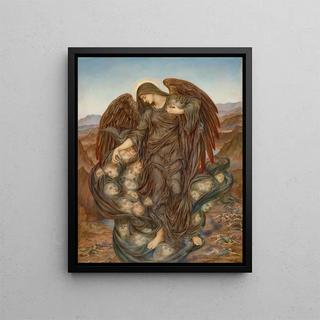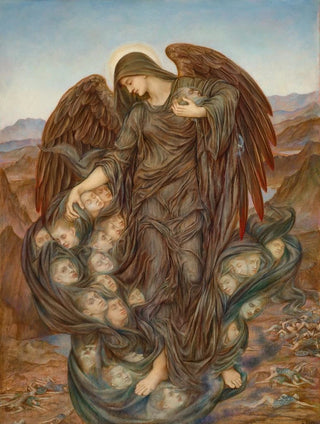Art print | The Field of the Killed - Evelyn De Morgan Source: Reproduction | Le Champ des tués - Evelyn De Morgan


View from behind

Frame (optional)
In the rich and complex universe of Victorian art, "The Field of the Killed" by Evelyn De Morgan stands out for its emotional depth and its commitment to social and spiritual themes. This artwork, created in 1898, evokes the tragedy of war and the devastating consequences it engenders. Through a powerful visual language, De Morgan transports us to a world where human suffering confronts divine beauty. The scene, imbued with melancholy, invites reflection on sacrifice and redemption, while highlighting the fragility of life. This art print allows us to deepen our understanding of the artist's intention and to appreciate the richness of her message.
Style and uniqueness of the work
Evelyn De Morgan's style is characterized by a harmonious fusion of symbolism and Pre-Raphaelitism. "The Field of the Killed" features a palette of vibrant colors, where warm and cool tones intertwine to create an atmosphere that is both poignant and contemplative. The human figures, although stylized, are imbued with great expressiveness, capturing emotions ranging from pain to hope. De Morgan also uses floral motifs and natural elements to reinforce the link between life and death, which is particularly visible in the meticulous details of the composition. This aesthetic choice enhances the spiritual dimension of the work, inviting the viewer to meditate on the cycle of existence. The pictorial technique, which combines finesse and intensity, demonstrates exceptional craftsmanship, allowing the piece to resonate deeply with those who contemplate it.
The artist and her influence
Evelyn De Morgan, an emblematic figure of the Victorian artistic movement, managed to establish herself in a milieu dominated by male artists. Born in 1855, she was strongly influenced by the progressive ideas of her time, particularly regarding women's rights and social issues. Her commitment to humanitarian causes is evident in her works, which address themes such as war, suffering, and spirituality. De Morgan was also a pioneer in the use of

Matte finish

View from behind

Frame (optional)
In the rich and complex universe of Victorian art, "The Field of the Killed" by Evelyn De Morgan stands out for its emotional depth and its commitment to social and spiritual themes. This artwork, created in 1898, evokes the tragedy of war and the devastating consequences it engenders. Through a powerful visual language, De Morgan transports us to a world where human suffering confronts divine beauty. The scene, imbued with melancholy, invites reflection on sacrifice and redemption, while highlighting the fragility of life. This art print allows us to deepen our understanding of the artist's intention and to appreciate the richness of her message.
Style and uniqueness of the work
Evelyn De Morgan's style is characterized by a harmonious fusion of symbolism and Pre-Raphaelitism. "The Field of the Killed" features a palette of vibrant colors, where warm and cool tones intertwine to create an atmosphere that is both poignant and contemplative. The human figures, although stylized, are imbued with great expressiveness, capturing emotions ranging from pain to hope. De Morgan also uses floral motifs and natural elements to reinforce the link between life and death, which is particularly visible in the meticulous details of the composition. This aesthetic choice enhances the spiritual dimension of the work, inviting the viewer to meditate on the cycle of existence. The pictorial technique, which combines finesse and intensity, demonstrates exceptional craftsmanship, allowing the piece to resonate deeply with those who contemplate it.
The artist and her influence
Evelyn De Morgan, an emblematic figure of the Victorian artistic movement, managed to establish herself in a milieu dominated by male artists. Born in 1855, she was strongly influenced by the progressive ideas of her time, particularly regarding women's rights and social issues. Her commitment to humanitarian causes is evident in her works, which address themes such as war, suffering, and spirituality. De Morgan was also a pioneer in the use of






